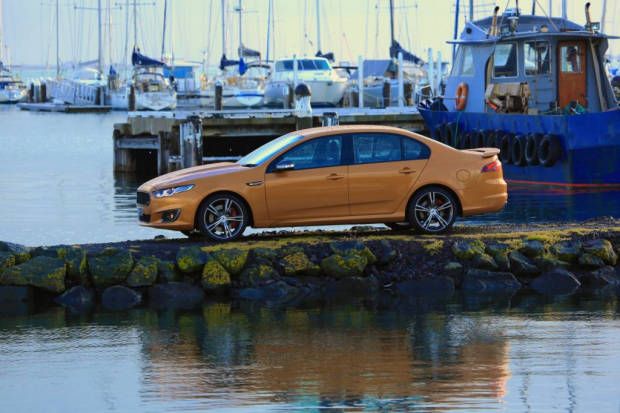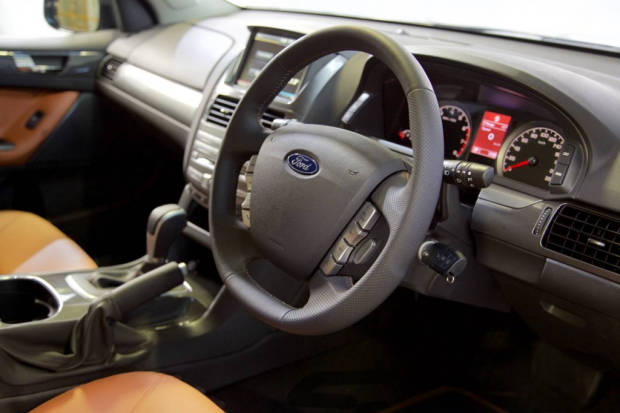-
Car Reviews
- All reviews
- Midsize SUVs
- Small cars
- Utes
- Small SUVs
- Large SUVs
- Large cars
- Sports SUVs
- Sports cars
- Vans
Latest reviews
- Car News
-
Car Comparisons
Latest comparisons
- Chasing Deals
Local car manufacturing is winding down in Australia, for better or worse. As the departure process begins, we’re seeing the mainstay manufacturers of Holden, Ford, and Toyota announce their last local products. An undoubtedly sad occasion, this week was Ford’s turn to release their FG X Falcon—the last Falcon we’ll see made on Australian soil.
In fact, it might be the last Ford to ever wear the Falcon nameplate. We think it’s fairly likely that Ford, like Holden, will retire their flagship model name in deference to the decades spent by local workers, toiling to build cars designed to spend a lifetime travelling in the Australian sun.
These last-ever models represent the peak of Australian car manufacturing ability. These are the last, but the best, cars that will ever wear name. The Falcon joins Holden’s VF Commodore as the best we’ll ever see of these cars.
Built in Campbellfield, near Geelong, the FG X follows all previous generations of Australian-made Falcons, in being Victorian-made. The Broadmeadows Assembly was opened fifty-five years ago, in 1959. There’s an emotional circularity at the Broadmeadows plant: it was purpose-built for the XK Falcon of 1960, and it will close when the last FG X rolls off the production line in 2016.
The new FG X Falcon maintains plenty of the parts and character of the previous FG model. The front-end and rear-end are all-new; the interior receives technological updates; and at the sportier end of the range, the hero XR8 performance model returns to save the day, now with a supercharged five-litre V8.
So, while it’s broadly a similar car to the one it replaces, the FG X Falcon is, in many ways, the car we always wanted the Falcon to be. It looks better—even Jaguar-like—and it’s easier to live with.

These last Falcons are punctuated by good value across the range. The age of these models—with interiors dating back to the early 2000s—means that in many aspects, they’re outclassed by newer (and smaller) competitors. But the Falcon is large, comfortable, refined, and capable. Starting in the mid-$30,000s range, you’re getting plenty of car for your money.
Two identically-priced engines will be offered for the most basic Falcon ($35,900). The venerable four-litre six carries over—and so does the better, newer two-litre EcoBoost turbo four. The base car’s popularity as a fleet special will decline towards the end of production.
The selection of premium Falcons has been rationalised to two models: the Falcon G6E, like the base car available with the four-litre or the two-litre (both $40,110).
The G6E Turbo returns as the barnstorming king of premium Fords in Australia. Once again, it uses the same 270kW turbocharged four-litre six as the XR6 Turbo. With a 0-100 sprint in the low six second range, the value is even better now at $46,550.
For the last few years, performance Falcons have been offered exclusively with six-cylinder engines. Both are available here: the base 195kW XR6 manual is actually the cheapest new Falcon ($35,590). The automatic adds $2,200. The XR6 Turbo ($42,990 as a manual) is certainly an investment over the price-leading XR6—but it’s nearly 40% more powerful again.
But the big ticket here is that the eight-cylinder XR8 returns. It now makes use of FPV’s five-litre supercharged V8. There’s a huge 335kW of power—easily trumping the Commodore SS’s 270kW. It looks and drives mean. But the best part: the manual lists for just $52,490—there’s no better bang for buck.

1960 was the year that Ford first built the Falcon in Australia. The sixties—a simpler era, where big cars were an aspiration and road trips were a more common family holiday—are a far cry from the second decade of the 21st century. These days, air travel is cheap and the road trip is in decline. Highway travel seems to require an SUV now, with seat-back entertainment to keep the kids entertained. We are urbanising faster and faster: key amenities are available in most Australian neighbourhoods—small cars are more suited to this task. And with public transport getting better and better, more young Australians are eschewing cars entirely.
So, what is the place of the large sedan in Australia?
Ford Australia believe that there isn’t one in future. The Falcon will be replaced by the next Mondeo, which is medium-sized. The sportier models will be succeeded by the Mustang coupe. But a big sedan? By the end of this decade, Ford won’t sell one.
This is a sad fact. While planes have made Australia a ‘smaller’ country than ever before, travelling those distances on the ground is still a gruelling, long task. Cars like the Falcon, and the Commodore, make multi-thousand-kilometre trips that much easier. The high-riding driving positions of SUVs become tiring during highway travel; sedans seem to wrap around you and your family. Their low centre of gravity improves handling. And with their long wheelbases, the flagship Holdens and Fords offer the kind of passenger space and rear-wheel-drive dynamics that smaller, newer models can only dream of.
It’s easy to get nostalgic.
Despite this, it is more important to acknowledge that the market has to decide whether a car remains relevant. It’s cut and dry when you look at it this day: in 2002, Ford moved over 54,000 Falcons. Last year, they sold a few more than 14,000. That figure is not sustainable.
Buyers are either upsizing—to the ubiquitous SUV—or downsizing, to more efficient, more modern, smaller models. Is that a shame? In many ways, it is: these large sedans almost singlehandedly drove Australia into the reality of modern personal motoring. But, in a painful quirk of our progress as a motoring nation, that the road the Ford Falcon paved ended up consigning it to irrelevance.
Latest news
About Chasing cars
Chasing Cars reviews are 100% independent.
Because we are powered by Budget Direct Insurance, we don’t receive advertising or sales revenue from car manufacturers.
We’re truly independent – giving you Australia’s best car reviews.